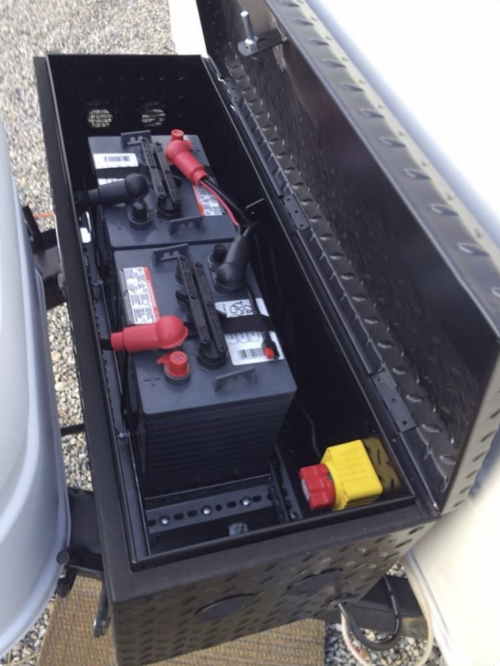If you buy through affiliate links, we may earn commissions, which help support our product reviews.
Last Updated: Jan 5, 2024
The number of deep cycles you can do each day matters for you and your RV camping experience.
Having to stop and charge your travel trailer battery can be very inconvenient.
A good battery can help you extend your workday without the headaches of recharging.
In this article, I’ll discuss the different types of batteries for your travel trailer or RV, their benefits, and costs.
Types of Batteries for Your Travel Trailer
The type of material and chemicals used to make a battery is important to its performance and longevity.
This can also affect the weight of the battery as well as temperature characteristics and shelf life.
Lead Acid (SLA or Flooded)
We have all had lead-acid batteries and are familiar with these types as well as their characteristics and uses from cars to trailers.
Lead-acid batteries can be sealed using AGM material, so they are no maintenance. They can also be flooded or wet batteries requiring you to top them off with water and they need to be vented.
However, with lead-acid you can only cycle them or use about 50% before they need to be charged again, you cannot use the entire 100% charge (drop below 11 volts) of the battery or they will not last as long, reduced cycles.
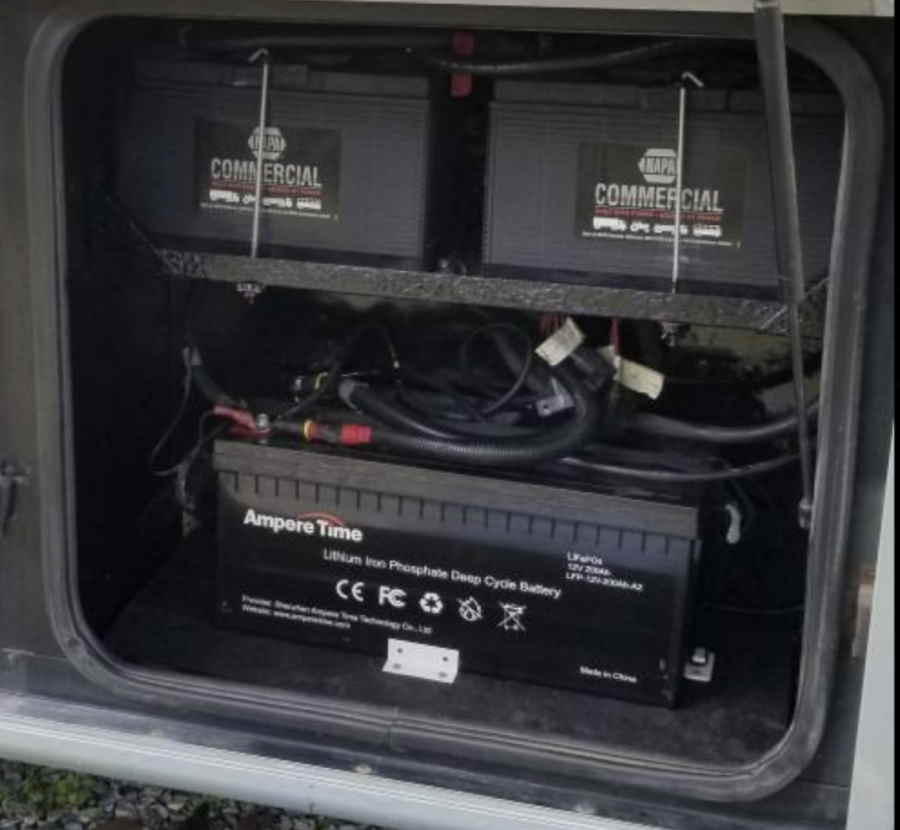
Lithium Iron Phostphate (LiFePO4)
We have certainly seen the rise and widespread use of lithium batteries in everything we use from flashlights, cell phones and EV electric vehicles.
Lithium batteries typically have huge advantages over lead-acid batteries:
- Weight (lithium batteries are much lighter than lead-acid)
- Energy Density (lithium stores much more energy than lead-acid)
- Stable Voltage (lithium batteries can maintain their rated/nominal voltage during use)
- Deep cycling (lithium batteries can be depleted 100% without lasting damage)
- Recharge Cycles (lithium batteries can be charged/discharged thousands of times)
With these advantages comes a few caveats.
Lithium batteries cannot be charged at temperatures below freezing (32F). Either let the battery warm-up, or wrap it with a heater, or heating pad prior to charging.
Lithium batteries are more expensive than lead-acid batteries. However, they tend to last much longer with many more cycles.
They are also not meant for high-surge current applications like starting a car, but they are best in class for everything else.
Which Battery is Best for your RV
You should consider which type of battery is best for your needs based on how you are going to use your RV:
Do you enjoy dry camping/boondocking or do you go from campsite to campsite and plug in most of the time?
If you don’t use the batteries that much, you could be fine using the lead-acid AGM-type batteries.
If you boondock or just want to use 100% of the battery when needed, then you should consider lithium batteries. There are a few mentioned in our guide to 12v batteries for RV or Dry Camping.
Also, with lithium batteries, even though they are more expensive than lead-acid, they give you much lower total cost of ownership over time.
Consider where the Batteries are Installed
Since the LiFePO4 (lithium) batteries can’t charge below freezing (< 32F), you should install them in the part of your travel trailer that can stay above freezing, like next to the water tank, deeper in a compartment, etc.
You can also wrap them with an insulation kit to help. They can also be mounted on their side or stacked if needed.
For lead-acid batteries, if they are flooded, they may need venting and maintenance. You could also use portable batteries for camping.
Get the Correct Charger for Lithium Batteries
The lithium batteries need a charging voltage of about 14.4 Volts. So, you should get a charger that is compatible with LiFePO4 batteries or has that setting.
This is important for the longevity of the battery or if you leave your RV plugged in to shore power.
You can also add an MPPT solar charge controller and a solar panel to help keep your batteries charged when not plugged in to shore power.
Best Batteries for Travel Trailers Reviewed:
CHINS LiFePO4 Battery 12V 100AH
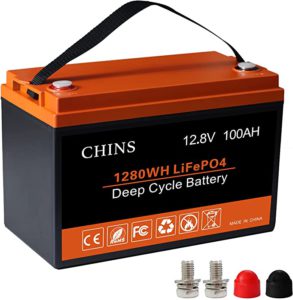 Power Rating: 12V 100Ah (1280Wh)
Power Rating: 12V 100Ah (1280Wh)Battery Type: LiFePO4
Max Discharge Current: 100A (1C)
Depth of Discharge: 100%
Charge Temperature: 32 to 120°F
Discharge Temperature: -4 to 140°F
Built-in BMS: Yes
Weight: 24.5 lbs
Dimensions: 12.95 x 6.77 x 8.43 inches Check Price
Setup & Install Experience:
This is a great battery with a lot of steady power when needed as it has 100A of continuous drain, if ever needed.
It has M8 terminal screws with protective caps. It also has an excellent peak discharge rate of 300A for 5 seconds. The internal BMS provides protection, so the LiFepo4 battery will not burn when overcharged, over-discharged, overcurrent, or short circuit, and can withstand high temperatures without decomposition.
Also, note that battery life depends on the number of charge/discharge cycles you do with your travel trailer.
Pros
- Solid performance;
- Max 4S4P configuration;
- Maintenance Free;
- 3 Year warranty;
- Optimal charge time 6 hours @ 20A;
- Charge voltage: 14.2 ~ 14.6V;
Cons
- No charger included;
Performance & Overall Experience:
This CHINS LiFePO4 battery is a workhorse.
It can be connected in parallel and in series for larger capacity and voltage. Max connection in series: Up to 4 identical batteries for up to 48V connecting in series.
Connection in parallels: it can connect multiple batteries, suggesting no more than 4pcs in parallel. Allow being extended up to 4 in series and 4 in parallel (Max 4S4P) to get more capacity (Max 400Ah) and higher voltage (24V, 36V, 48V). Other installation configurations are 4S2P, 2S2P, 3S2P, etc.
In cold climates, monitor temperatures, if it’s too cold to charge the battery (< 32F) we used a heating pad around the battery to warm it, then charged it.
With all of those amazing features, you’ll rest easy knowing that, you can get many more cycles from this lithium battery than a lead-acid (SLA).
Tested Features:
- Charging 14.4V @ 25C.
- Several Cycles @ 14 foot trailer.
- Resting voltage: 12.81V.
- Cut-off Voltage: 10.88V
- Inverter compatible;
Technical Details:
| Dimensions | 12.95 x 6.77 x 8.43 inches |
| Weight | 24.47 lbs |
| Model number | CHINS LAF 12100 |
| Batteries | 4 x LiFePO4 cells |
SCREMOWER LiFePO4 Battery 12V 100AH with Charger & 5V USB Built-In
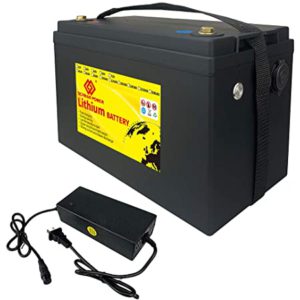 Power Rating: 12V 100Ah (1280Wh)
Power Rating: 12V 100Ah (1280Wh)Battery Type: LiFePO4
Max Discharge Current: 50A (.5C)
Depth of Discharge: 100%
Charge Temperature: 32 to 120°F
Discharge Temperature: -4 to 140°F
Built-in BMS: Yes
Weight: 24.2 lbs
Dimensions: 13.1 x 6.9 x 8.7 inches Check Price
Setup & Install Experience:
This is a great battery with a lot of steady power when needed as it has 50A of continuous drain.
It has M8 copper terminal screws. It also has an excellent peak discharge rate of 50A. The internal BMS provides protection, so the LiFepo4 battery will not burn when overcharged, over-discharged, overcurrent, or short circuit, and can withstand high temperatures without decomposition.
Also, note that battery life depends on the number of full cycles you do with your travel trailer.
Pros
- Solid performance;
- Max 4S4P configuration;
- Maintenance Free;
- 5 Year warranty;
- Optimal charge time 5 hours @ 10A;
- Charge voltage: 14.2 ~ 14.6V;
Cons
- No terminal caps;
Performance & Overall Experience:
This SCREMOWER is great with the included charger included. The 5v USB ports are a great for connecting your phone or a GPS tracker for your RV.
It can be connected in parallel and in series for larger capacity and voltage. Max connection in series: Up to 4 identical batteries for up to 48V connecting in series.
Connection in parallels: it can connect multiple batteries, suggesting no more than 4pcs in parallel. Allow being extended up to 4 in series and 4 in parallel (Max 4S4P) to get more capacity (Max 400Ah) and higher voltage (24V, 36V, 48V). Other installation configurations are 4S2P, 2S2P, 3S2P, etc.
When temperatures are too cold to charge the battery (< 32F) we have used a heating pad around the battery to warm it, then charged it.
With all of those amazing features, you’ll rest easy knowing that, you can get many cycles from this lithium battery than a lead acid (SLA).
Tested Features:
- Charging 14.4V @ 25C.
- Several Cycles @ 14 foot trailer.
- Resting voltage: 12.05V.
- Cut-off Voltage: 10.9V
- Inverter compatible;
Technical Details:
| Dimensions | 13.1 x 6.9 x 8.7 inches |
| Weight | 24.2 lbs |
| Model number | SCREMOWER 12VSCR100Ah |
| Batteries | 4 x LiFePO4 cells |
WEIZE 12V 100AH AGM SLA Battery
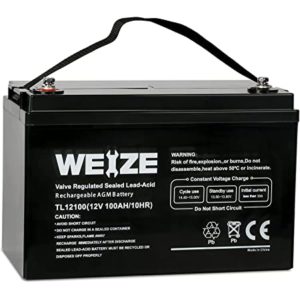 Power Rating: 12V 100Ah (1280Wh)
Power Rating: 12V 100Ah (1280Wh)Battery Type: AGM (SLA)
Max Discharge Current: 100A (1C)
Depth of Discharge: 100%
Charge Temperature: 32 to 120°F
Discharge Temperature: -4 to 140°F
Built-in BMS: Yes
Weight: 60 lbs
Dimensions: 12.99 x 6.73 x 8.34 inches Check Price
Setup & Install Experience:
SLA batteries have a low self-discharge rate – about 40% per year or 3.3% per month. These batteries are able to be stored without charging for up to 5-6 months when at full capacity, but doing so is not recommended. At least every 2-3 months you should top charge them. In order to prolong their shelf life, SLA batteries should be stored and maintained properly.
It has M8 terminal screws with protective caps.
Deep cycle AGM batteries, have a measure capacity in Watt/Hours. It means, that a 12 Volt, 100 Ah battery, as 12×100 = 1200 watt/hours.. translate to english, it provides 1200 watt in 1 Hour , until it totally depleted., or 600 watt in 2 Hour, 300 watt in 4 hour, 100 Watt in 12 hours.
Also, note that battery life depends on the how fast you discharge the battery.
Pros
- Solid performance;
- Max 4S4P configuration;
- Maintenance Free;
- 3 Year warranty;
- Optimal charge time 6 hours @ 20A;
- Charge voltage: 14.2 ~ 14.6V;
Cons
- No charger included;
Performance & Overall Experience:
This AGM battery is a workhorse.
It can be connected in parallel and in series for larger capacity and voltage. Max connection in series: Up to 4 identical batteries for up to 48V connecting in series.
Connection in parallels: it can connect multiple batteries, suggesting no more than 4pcs in parallel. Allow being extended up to 4 in series and 4 in parallel (Max 4S4P) to get more capacity (Max 400Ah) and higher voltage (24V, 36V, 48V). Other installation configurations are 4S2P, 2S2P, 3S2P, etc.
When temperatures are too cold to charge the battery (< 32F) we have used a heating pad around the battery to warm it, then charged it.
With all of those amazing features, you’ll rest easy knowing that, you can get many more cycles from this lithium battery than a flooded lead-acid battery.
Tested Features:
- Charging 14.4V @ 25C.
- Several Cycles @ 14 foot trailer.
- Resting voltage: 12.81V.
- Cut-off Voltage: 10.88V
- Inverter compatible;
Technical Details:
| Dimensions | 12.95 x 6.77 x 8.43 inches |
| Weight | 24.47 lbs |
| Model number | CHINS LAF 12100 |
| Batteries | 4 x LiFePO4 cells |
How to Install a Battery in your Travel Trailer
- Make sure any accessories are turned off inside the trailer and disconnected from the tow vehicle.
- Unscrew the positive and negative terminal cables.
- Remove the old battery.
- Clean the tray area and adjust cables, if necessary
- Put the new battery in place.
- Attach the Negative, then Positive cables, snug, don’t over-tighten
- Place rubber boots or protective caps on the terminals
- Test the battery from your travel trailer
- Attach the charger and charge the battery before general use.
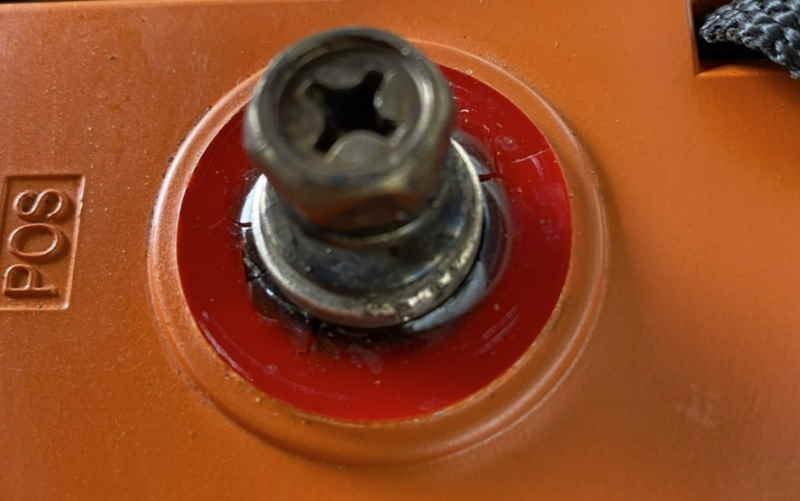
Note: You may need longer terminal screws or bolts if the stock ones are not long enough for your power cables.
Conclusion
There are many options when selecting a battery for your travel trailer or camper.
It is obvious that the lithium LiFePO4 batteries have many advantages over lead-acid. But you may have other reasons to go with either one.
FAQs
How long does a Travel Trailer Battery Last?
Depending on the kind of battery you use, you could get 2000-5000 cycles with lithium vs 200 – 500 on lead-acid batteries
